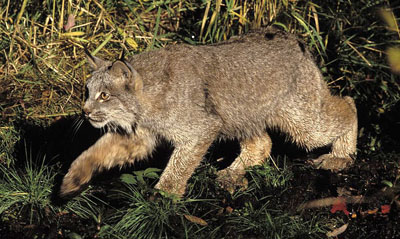Does statewide land conservation correlate with ecological values?
 Preservation
Preservation  Canada lynx (Lynx canadensis). Credit, Erwin and Peggy Bauer, U.S FWS.Organizations working to protect land have largely similar missions – to conserve natural resources, broadly defined, and provide public benefits.
Canada lynx (Lynx canadensis). Credit, Erwin and Peggy Bauer, U.S FWS.Organizations working to protect land have largely similar missions – to conserve natural resources, broadly defined, and provide public benefits.
However when numerous organizations are working across the same geographic area on their own projects protecting land, the question arises whether their cummulative efforts are achieving a succesful outcome for conservation.
Few studies have been done to assess that cumulative benefit in retrospect.
A recent analysis of the collective impact of conservation lands on ecological resources in the state of Maine provides a useful prototype for answering this question.
Christopher Cronan from the University of Maine and fellow researchers used a GIS-based approach to correlate the locations of conservation lands with mapped distributions of several different ecological values.
Over the past two decades in Maine, the percentage of the state’s total land area under some type of conservation ownership has risen from less than 5% to 17%.
The majority of this conservation activity has been undertaken by non-governmental organizations – land trusts and conservation groups.
A general overview revealed that most of the protected lands in Maine are located in the northern part of the state, away from the population centers along the coast.
The reason for this is likely twofold – land is typically cheaper in the north, and parcels are usually much larger, as the landscape is not nearly as fragmented by development.
Yet the study also found that the representation of land cover types across protected lands mirrored their overall proportion across the state.
However, more detailed analysis of protected lands revealed a more nuanced picture of conservation success.
The authors compared conservation lands with several indicators of ecological diversity. These indicators included mapped locations of threatened and endangered species, habitat of species found on the state’s Species of Greatest Conservation Need list, prime inland waterfowl habitat, and Canada lynx habitat.
They found that all of these indicators are underrepresented on land currently conserved in Maine.
Finally, of the locations identified by state agencies and NGOs as Focus Areas of Statewide Ecological Significance, less than a quarter are found on protected lands.
Because of the high cost of protecting land directly through ownership or conservation easement, much of the work done to date, especially by non-governmental organizations, has been opportunistic and biased toward lands owned by people willing to donate all or a portion of its value.
As a result, the correlation between conservation lands and ecological diversity and species habitat need is lower than if lands were pursued proactively to meet pre-determined criteria that would offer the maximum benefit.
The majority of land conservation activity in Maine is currently being undertaken by non-profit land trusts. The financial and human resources of these organizations are likely not equal to the identified conservation needs.
These non-profit groups would achieve maximum value for their effort by using a collaborative strategy developed from the known distribution of a variety of ecological resources, such as those used in this assessment.
--by Karen Bassler
Cronan, C., Lilieholm, R., Tremblay, J., & Glidden, T. (2010). An Assessment of Land Conservation Patterns in Maine Based on Spatial Analysis of Ecological and Socioeconomic Indicators Environmental Management DOI: 10.1007/s00267-010-9481-7




Reader Comments